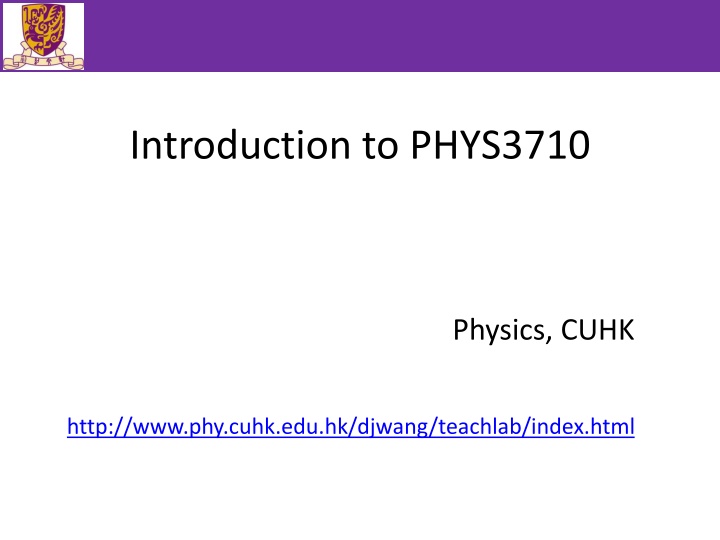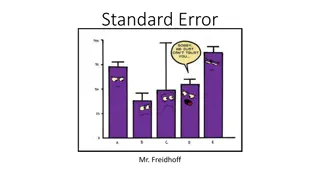
Physics Lab Course at CUHK: Hands-on Scientific Research Experience
Explore the Physics course at CUHK designed to provide students with practical research skills, experimental projects, and in-depth learning in modern physics and experimental techniques. The course emphasizes independent learning, data analysis, and communication skills essential for scientific research. Join to experience a systematic approach to tackling new scientific problems.
Uploaded on | 0 Views
Download Presentation

Please find below an Image/Link to download the presentation.
The content on the website is provided AS IS for your information and personal use only. It may not be sold, licensed, or shared on other websites without obtaining consent from the author. If you encounter any issues during the download, it is possible that the publisher has removed the file from their server.
You are allowed to download the files provided on this website for personal or commercial use, subject to the condition that they are used lawfully. All files are the property of their respective owners.
The content on the website is provided AS IS for your information and personal use only. It may not be sold, licensed, or shared on other websites without obtaining consent from the author.
E N D
Presentation Transcript
Introduction to PHYS3710 Physics, CUHK http://www.phy.cuhk.edu.hk/djwang/teachlab/index.html
Outline 1.About this course 2.The schedule 3.Some detailed requirements: lab notebook, data analysis, report writing 4.Assessment scheme 5.Lab safety reminder
Teaching team Professors: GOH Swee Kuan, LI Yufan, LU Xinhui, XU Lei and YAN Renbin Technician: Mr. Gary Lai TAs: XU Youhan, ZHOU Junfeng, WANG Yu, WU Yameng, TAO Yiran, LI Haoyuan
Background Physics is an experimental science, but there were only two lab courses in our old curriculum. Previous teaching lab courses (Lab I, II and III) provides only basic skills but didn t prepare our students for real scientific research and work. No independentexperimental project learning opportunities for students in the old physics curriculum.
Purpose Provide an opportunity for students to experience the whole process of scientific research. Skills to pick up: Independent learning, reading skill (to read some references at the beginning), time-management skill (keep track of the progress in taking data), honesty and organization (honest and organized to the data taken), data analysis, drawing conclusions from data, communication skills (scientific writing or/and oral reporting, discussions with instructors), Eventually, a systemic way of working on a new scientific problem.
Basic structure 1-unit; compulsory for all students; It is offered in the 1st term and the 2nd semesters; One short experimental project to finish independently, which illustrates modern physics and/or experimental technique; For each project, a student should plan to work in the lab for at least 5 days, but no more than 10 days; Prerequisite: PHYS1712 and 2711; special permission of the instructor otherwise.
Projects 1 2 3 4 5 6 7 8 9 Special rel. C60 Radiometer Rutherford Muon Cavity NMR High Tc YBCO CCD Brownian Single photon Nuclear detector Coupled Osc. Soliton Heat engine Cu-Ni alloy Diodes Saturation spectrosco py 1. Modern physics and nuclear physics: special relativity, Rutherford scattering, nuclear detector, muon lifetime Solid state physics: C60, High Tc Superconductor YBCO, magnetic properties of Cu-Ni alloy Optics and electronics: optical cavity, ccd, diodes, Brownian Quantum physics: Single photon interferometer, saturation spectroscopy, optical cavity, NMR Other: Water soliton, coupled osc., heat engine 2. 3. 4. 5.
Outline 1.About this course 2.The schedule 3.Some detailed requirements: lab notebook, data analysis, report writing 4.Assessment scheme 5.Lab safety reminder
Schedule Each project will be offered 3 times (except some with time conflicts due to instruments sharing); One person per slot; 1. Make your choice before the end of this Friday and mark your name on the whiteboard in room 216 (need to come in person). Please also leave your contact info in the PC opposite the whiteboard.
Schedule: preparation 2. Find out the TA and professor in charge of your project.
Schedule: preparation 3. Contact Mr. Lai for the lab manual and references (E-copy). Get in touch with the TA ASAP. 4. Study the references with the help of TA/technician. 5. Make an appointment and discuss with the professor in charge of your project within the first week of your session (as early as possible). 6. During the discussion, you should show your understanding and plan including your working schedule of the selected project. 7. Can t start the experimental part without the Prof s approval.
Schedule: Lab sessions 8. Lab sessions: each group should finish the project, including preparation, data taking and analyzing within 18 days starting from the designated date 9. Another one weeks for report writing. The professors offer a proof-reading opportunity for your draft report if the report is submitted 3 days before the due date.
Schedule: note to lab sessions You need to follow your planned schedule: otherwise no one can follow and help you. Try to get things done with maximum independence: think hard enough before asking for help, but don t hesitate to ask for help. TAs, technician and professors are available, but you need to make appointments in advance. Running experiment after 5:30 pm alone is not allowed: university rule. In special cases, you need to make arrangement with TAs in advance.
Outline 1.About this course 2.The special schedule 3.Some detailed requirements: lab notebook, data analysis, report writing 4.Assessment scheme 5.Lab safety reminder
Lab notebook It is one of the most important part of this course It should be in a detailed, organized, dairy style and reflect the real-time progress of the project It should include, but not limited to these: physics understanding of the project in your own words, overall procedure, experimental schematics, records of experimental parameters, plots of raw data, details of your analysis, results and conclusions All contents on the notebook should be permanent, including mistakes (marked by strikethrough lines) Handwriting should be legible (to you and to others) It should be submitted together with your report Ask Mr. Gary Lai for the notebook itself when choosing your project
Data analysis One of the most important parts of scientific research: in many cases, data analysis takes more time than data taking! One common mistake: show lots of raw data without any analysis! Others: errors misrepresented, units missing Pay attention to significant digits
NaRb spinor dynamics at 1.0G NaRb spinor dynamics at 1.2G NaRb spinor dynamics at 1.4G NaRb spinor dynamics at 0.8G 1.0 1.0 1.0 1.0 Data: Rb_B Data: Rb_B Model: DampingSin2 y0 0.39627 A -0.0619 0.00598 T0 8.88496 phi -7.11416 tau 27.37749 tau2 28.90172 A1 0.10322 |1,-1># |1,0># |1,1># |1,-1># |1,0># |1,1># |1,-1># |1,0># |1,1># Data: Rb_B Model: DampingSin2 y0 0.32578 A -0.04055 T0 7.52412 phi -75.65527 tau 56.27571 tau2 38.02367 A1 0.18685 Data: Rb_B Model: DampingSin2 y0 0.42565 A -0.03103 T0 6.89897 phi -94.87207 tau 103616.7472 tau2 2911799.44473 1.3216E13 A1 0.05454 |1,-1># |1,0># |1,1># 1.01091 0.01033 0.15818 0.12743 35.1747 3605.61448 1.0042 y0 A T0 phi tau tau2 A1 0.51916 0.07827 13.99442 -129.84103 82.46655 170.07381 -0.05494 0.09148 0.26694 0.00753 0.1559 0.15998 64.74487 69.57417 0.26098 246115.54654 0.02654 0.56677 0.39348 1478425650.71175 0.8 0.8 0.8 0.8 0.09986 0.08137 7.51298 36.31086 0.08698 0.6 0.6 0.6 0.6 Rb frac Rb frac Rb frac 246115.54654 Rb frac Data: Rb_C Model: DampingSin2 Data: Rb_C Model: DampingSin2 y0 0.51197 A -0.04112 T0 7.38223 phi -72.61333 tau 7603.87848 tau2 47.39216 A1 -0.09115 Data: Rb_C Model: DampingSin2 y0 0.59393 A -0.07066 T0 9.32234 phi -10.01841 tau 48.64787 tau2 39.25905 A1 -0.15847 Data: Rb_C Model: DampingSin2 y0 0.32626 A -0.07059 T0 12.86658 phi -89.93853 tau 69712.18769 tau2 2622007.93609 -- A1 0.04988 0.4 0.4 0.4 0.4 -- 0.02337 0.34405 0.25232 87.45362 -- -- y0 A T0 phi tau tau2 A1 0.42862 0.08264 14.51113 -132.64579 87.27093 118785.0087 -0.00076 0.30527 0.00494 0.08929 0.10395 717927.81035 193.42723 0.30104 0.38017 0.01243 0.15875 0.12612 41.19926 121.84749 0.36991 -- 0.36359 13.98813 1.15073 2253541578.48345 0.2 0.2 0.2 0.2 -- 0.0 0.0 0.0 0.0 0 5 10 15 20 0 5 10 15 20 0 10 20 30 40 50 0 2 Holding Time /ms 4 6 8 10 Holding Time /ms Holding Time /ms Holding Time /ms NaRb spinor dynamics at 1.4G NaRb spinor dynamics at 1.55G NaRb spinor dynamics at 1.6G NaRb spinor dynamics at 1.5G 1.0 1.0 1.0 |1,-1># |1,0># |1,1># Data: Rb_B Model: DampingSin2 y0 0.47698 A -0.07442 T0 14.17404 phi -32.30667 tau 79.5148 tau2 1512.75971 A1 1.7728E-7 |1,-1># |1,0># |1,1># Data: Rb_B Model: DampingSin2 y0 0.43734 A -0.35127 T0 68.31303 phi -13.17254 tau 115.17952 tau2 0.99397 A1 -0.21183 Data: Rb_B Model: DampingSin2 y0 0.94051 A -0.19281 T0 34.16282 phi -63.54334 tau 85.08625 tau2 303.24475 A1 -0.5217 4.1263 |1,-1># |1,0># |1,1># 1.0 42.38377 0.00584 0.10074 0.07552 19.78833 369571026925.15283 42.37977 0.00816 0.03443 1.52517 0.10349 24.49345 18.24571 3.82797 4.15044 0.03837 0.95543 0.18193 40.95615 2746.7673 |1,-1># |1,0># |1,1># 0.8 0.8 0.8 Data: Rb_B Model: DampingSin2 y0 0.64309 A -0.11669 T0 21.39872 phi -45.00587 tau 126.02279 tau2 116.44737 A1 -0.19726 0.31756 0.00793 0.18641 0.06602 37.92592 235.09907 0.31178 0.8 0.6 0.6 0.6 Rb frac Rb frac Rb frac 0.6 Rb frac 0.4 0.4 0.4 Data: Rb_C Model: DampingSin2 y0 0.45364 A -0.40649 T0 68.99025 phi -9.97993 tau 88.21132 tau2 2.4533 4.20053 A1 0.17273 Data: Rb_C Model: DampingSin2 y0 0.42082 A -0.08555 T0 14.55697 phi -35.12327 tau 51.0192 tau2 1211.56348 A1 1.0447E-6 Data: Rb_C Model: DampingSin2 y0 0.04995 A -0.19655 T0 33.37892 phi -60.48748 tau 75.79341 tau2 163.67043 A1 0.48205 0.00824 0.03666 1.76432 0.11746 14.1622 0.4 102.55281 0.02515 0.41044 0.25651 32.93271 122051421009.34157 102.53742 Data: Rb_C Model: DampingSin2 y0 0.24764 A -0.12196 T0 21.51929 phi -41.78635 tau 88.18886 tau2 128.22898 A1 0.2385 0.36649 1.18164 0.03711 0.96137 0.18533 31.85846 506.5518 1.1584 0.3722 0.00816 0.19032 0.06334 19.0722 246.41827 0.2 0.2 0.2 0.2 0.10062 0.0 0.0 0.0 0 20 40 60 80 0 10 20 30 40 50 0 20 40 60 80 100 0.0 Holding Time /ms Holding Time /ms Holding Time /ms 0 10 Holding Time /ms 20 30 40 50 NaRb spinor dynamics at 1.69G NaRb spinor dynamics at 1.7G NaRb spinor dynamics at 1.65G 1.0NaRb spinor dynamics at 1.675G 1.0 Data: Rb_B Model: DampingSin2 y0 0.66234 A -0.14943 T0 44.76376 phi -105.72278 tau 75.30451 tau2 1097.62901 A1 0.06585 1.0 |1,-1># |1,0># |1,1># 1.0 37.19968 0.04029 2.54123 0.31567 44.6488 653870.07829 37.16961 |1,-1># |1,0># |1,1># Data: Rb_B Model: DampingSin2 y0 0.94805 A -0.23364 T0 86.86477 phi -62.96322 tau 70.28112 tau2 1239.49174 A1 -0.35108 |1,-1># |1,0># |1,1># Data: Rb_B Model: DampingSin2 y0 0.2407 0.57772 A -0.23543 T0 37.94663 phi -49.18153 tau 29.99668 tau2 256.88562 A1 0.54356 |1,-1># |1,0># |1,1># 0.8 21.22553 0.06597 5.36777 0.20074 21.29944 80978.84223 21.17759 0.8 0.8 0.8 0.02462 1.2989 0.13944 4.7579 351.65232 0.56336 0.6 Rb frac 0.6 0.6 0.6 Rb frac Rb frac Rb frac Data: Rb_C Model: DampingSin2 y0 0.12759 A -0.15109 T0 44.92455 phi -115.18158 tau 80.21661 tau2 127258.44052 2.0514E12 A1 0.07295 0.4 1169671.43937 0.05458 2.42442 0.31891 53.30922 0.4 0.4 0.4 Data: Rb_C Model: DampingSin2 y0 0.70077 A -0.21503 T0 37.96456 phi -52.29301 tau 33.2292 tau2 314.85072 A1 -0.54947 Data: Rb_C Model: DampingSin2 y0 0.28508 A -0.25723 T0 75.01511 phi -73.06349 tau 65.99894 tau2 12.25998 A1 0.27373 0.77707 0.0207 1.12437 0.12938 4.9157 547.50984 0.7647 0.00606 0.05834 2.46424 0.15331 14.59972 4.76263 0.05896 0.2 0.2 0.2 0.2 1169671.37013 0.0 0 20 40 60 80 100 0.0 0.0 0.0 Holding Time /ms 0 50 100 150 0 50 100 150 200 20 Holding Time /ms NaRb spinor dynamics at 2.1G 0 40 60 80 100 120 Holding Time /ms Holding Time /ms NaRb spinor dynamics at 1.8G NaRb spinor dynamics at 1.9G NaRb spinor dynamics at 1.75G 1.0 1.0 1.0 1.0 |1,-1># |1,0># |1,1># Data: Rb_B Model: DampingSin2 y0 0.40314 A -0.03531 T0 5.45297 phi -77.93412 tau 38380.63338 tau2 162.20095 A1 0.19095 Data: Rb_B Model: DampingSin2 y0 0.60628 A -0.11482 T0 17.37064 phi -17.24488 tau 51.95701 tau2 14.25254 A1 0.09406 |1,-1># |1,0># |1,1># |1,-1># |1,0># |1,1># Data: Rb_B Model: DampingSin2 y0 0.6214 46.53083 A -0.05934 T0 10.92782 phi -29.23726 tau 154.83367 tau2 -813.25398 A1 1.5517E-7 |1,-1># |1,0># |1,1># 5.072 0.00404 0.07981 0.14933 20131810.3814 4539.5521 5.06745 0.00711 0.00947 0.1929 0.10101 9.63915 4.7225 0.01225 Data: Rb_B Model: DampingSin2 y0 0.61104 A 0.19005 T0 22.78088 phi -121.13531 tau 32.64894 tau2 11.80403 A1 0.16834 0.8 0.8 0.8 0.00715 0.14336 0.12323 157.50679 237861766045.83994 46.52424 0.01272 0.03704 0.642 0.19048 9.41995 5.80936 0.04558 0.8 0.6 0.6 0.6 Rb frac Rb frac Rb frac 0.6 Rb frac Data: Rb_C Model: DampingSin2 y0 0.31058 A -0.06335 T0 10.96878 phi -26.09342 tau 110.09157 tau2 1344.41047 A1 -7.9344E-6 Data: Rb_C Model: DampingSin2 y0 0.31056 A -0.12049 T0 17.4107 phi -20.38956 tau 49.04142 tau2 9.79618 A1 -0.08602 0.4 0.4 0.4 Data: Rb_C Model: DampingSin2 y0 0.19325 A -0.03662 T0 5.35671 phi -87.67837 tau 181449.16753 1007986260.94056 tau2 6240569.14108 7.0906E12 A1 0.15156 110.83892 0.00629 0.12146 0.10177 67.15833 19100736640.22623 110.83317 0.00505 0.01104 0.20446 0.10555 9.38145 3.59554 0.01735 0.4 Data: Rb_C Model: DampingSin2 y0 0.30467 A 0.18135 T0 22.9593 phi -124.26763 tau 34.86393 tau2 10.7521 A1 -0.15503 171244.6446 0.00983 0.19369 0.36987 0.00839 0.02714 0.46403 0.13922 7.71337 4.13737 0.0347 0.2 0.2 0.2 0.2 171244.6446 0.0 0.0 0.0 0 5 10 15 0 10 20 30 0 20 40 60 0.0 Holding Time /ms Holding Time /ms 0 10 Holding Time /ms 20 30 40 50 60 Holding Time /ms
Lab report Journal format: Physics Review (A,B,C,D,E) Latex is suggested (visit www.overleaf.com); Word is ok but harder to work with for journal papers. We can provide help for first time users. Organization: not fixed, just an example Title: Author and affiliation: Abstract: Main text in sections (just an example!): 1. Introduction 2. Theory 3. Experiment 4. Results and discussions 5. Conclusion Acknowledgements
Lab report: common mistakes Wrong format: harder to follow Physical Review format without using Latex Abstract: duplication of the first and last sentences of the main text! References: not in place Figures: without post-processing, without clear labels (with units) and marks Figures: too many. A series of measurements with only one changing variables should be compiled together to form one figure, if you want to show them. Figures: captions too simple. Everything shown should be explained clearly.
Outline 1.About this course 2.The special schedule 3.Some detailed requirements: lab notebook, data analysis, report writing 4.Assessment scheme 5.Lab safety reminder
Assessment scheme Submit the lab report, the raw data and the lab notebook to the professor in charge of your project. Submit in person or by email (preferred)! Don t use the box on the 2nd floor! Not only the report
Assessment scheme: more details Item Understand physics in project 10 Report Language Overall organization Title Abstract Figures and captions References Acknowledgement Measurement Quantity of data Quality of data Data analysis Proper analysis? Number and error representation Logbook Submitted? Content Raw data Timing Finish experiment on time Finish report in time Communication With professors TA and technician comments Cleanup, return reference Total marks Marks 5 4 2 4 5 3 2 10 5 10 5 We have 5 professors. To make sure the grading is more uniform, we will use a more detailed marking scheme. 5 5 5 5 10 5 2 2 104 (-1 per day of delay) (-2 per day of delay)
Assessment scheme: criterion referencing Grade Descriptors A : Demonstrate thorough mastery of the subject (of the project or seminar) required for attaining all the course learning outcomes. Demonstrate evidence of original thoughts and the ability of critical use of data or results to draw insightful conclusions, in a manner that would surpass the normal expectation at this level and standards that may be required at higher levels of study or research. Has the ability to express the knowledge and synthesis of ideas in a clear and cogent manner. A- : Demonstrate substantial command of the subject (of the project or seminar) required for attaining almost all the course learning outcomes. Demonstrate the ability of critical use of data or results to draw meaningful conclusions, in a manner that is logical and comprehensive. Has the ability to express the knowledge or application with clarity and accuracy. B : Demonstrate general and sufficient command of the subject (of the project or seminar) required for attaining most of the course learning outcomes. Demonstrate the ability of the use of data or results to draw mostly correct conclusions, in a manner that is logical and persuasive. Has the ability to express the knowledge or application in a satisfactory and unambiguous way. C : Demonstrate general command of the subject (of the project or seminar) required for attaining some of the course learning outcomes. Demonstrate the ability of the use of data or results to draw conclusions, but with occasional errors. Has the ability to express the separate pieces of knowledge in an unambiguous way. D : Demonstrate partial command the subject (of the project or seminar) required for attaining some of the course learning outcomes. Has limited ability to use data or results to draw conclusions. Has the ability to state the knowledge in simple terms. F : Demonstrate little or no evidence of command of subject (of the project or seminar) required for attaining the course learning outcomes, OR failure to meet specified assessment requirements.
Outline 1.About this course 2.The special schedule 3.Some detailed requirements: lab notebook, data analysis, report writing 4.Assessment scheme 5.Lab safety reminder
Last but not the least: Lab safety issues Extremely hazardous radiation: Nuclear, x-ray Chemicals: some solvents Electromagnetic radiation: lasers, radio and microwave frequency Low temperature: LN2, He High temperature: furnace HV and UHV Vacuum Make sure you understand the standard operation procedure in dealing with these; If you feel uncertain about any thing of these: stop and ask for help
Last but not the least: Lab safety issues We should always: Keep safety in mind ( ) Prevention is the key ( )
Thanks! Q&A






















